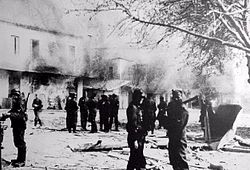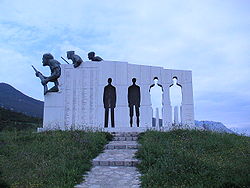- Distomo massacre
-
The Distomo massacre (Greek: Η σφαγή τού Διστόμου; German: Massaker von Distomo or Distomo-Massaker) was a Nazi war crime perpetrated by members of the Waffen-SS in the village of Distomo, Greece, during the Axis occupation of Greece during World War II.
Contents
History
On June 10, 1944, over two hours, Waffen-SS troops of the 4th SS Polizei Panzergrenadier Division under the command of SS-Hauptsturmführer Fritz Lautenbach went door to door and massacred Greek civilians, reportedly in revenge for a partisan attack. A total of 218 men, women and children were killed.[1] According to survivors, SS forces "bayoneted babies in their cribs, stabbed pregnant women, and beheaded the village priest."[1]
In the course of a 'retaliation measure' against partisan resistance members of the 4th SS-police-armoured-infantry-division murdered 218 completely uninvolved town dwellers on the 10th June 1944 in Distomo, a small village near Delphi. The battle report states that 'members and suspects of gangs' were killed. However, survivors of the massacre reported afterwards that men as well as children were shot, women were violated and slaughtered. No soldier was ever held responsible for the massacre.Argyris Sfountouris (protagonist of the film "A song for Argyris") was nearly four years of age in June 1944 and survived by chance. He lost his parents and 30 family members. Up until this day he and the other survivors and relatives have not received a single cent as compensation even though the Areopag, the Greek High court, has passed a legally binding decision in May 2000 obliging the Federal Republic of Germany to pay a sum of altogether 28 million Euro as compensation to the victims.
In the meantime Italian courts have likewise awarded compensation to Italian victims of the German occupation. The Greek victims were successful in their claim for enforceability of their legal titles against German property in Italy awarded by Greek courts. Germany has objected to this by saying that these were 'sovereign measures' and has claimed 'state immunity' for the war crimes and the crimes against international law. Both the Areopag as well as the Italian court of appeal have rejected this argument. In December 2008 the German government has filed a lawsuit at the International Court of Justice in Den Haag in order to circumvent the enforcement of the compensation claims. Its aim is to establish once and for all that this kind of lawsuits does not fall under the competence of the Italian courts, that their rulings constitute an infringement of international law and that they constitute an infringement of Germany' sovereignty rights.
Following the massacre, a Secret Field Police agent accompanying the German forces informed the authorities that, contrary to Lautenbach's official report, the German troops had come under attack several miles from Distomo and had not been fired upon "with mortars, machine-guns and rifles from the direction of Distomo". An inquiry was convened. Lautenbach admitted that he had gone beyond standing orders, but the tribunal found in his favour, holding that he had been motivated, not by negligence or ignorance, but by a sense of responsibility towards his men.[2]
Compensation demands
As the matter of reparations and restitution between Greece and Germany is not closed, survivors and relatives of the victims made claims for individual compensation and sued in the German courts and the European Court of Human Rights, which could have made Germany liable for several billion dollars in reparations. The claims were denied by the European Court of Human Rights and by German lower courts and in June 2003 were rejected by the Federal Court of Justice.[1][3] Federal Constitutional Court of Germany ruled in March 2006, it didn’t have to pay compensation to individuals seeking damages over war crimes.[4]
In November 2008, a court in Florence ruled that the families of the 218 men and women killed should be awarded a villa in Menaggio, near Lake Como, which is owned by a German state nonprofit organization, by way of restitution. Germany appealed against the Italian ruling.[5] In January 2011, Prime Minister of Greece George Papandreou announced that the Greek Government will be represented at the International Court of Justice in relation to the claim for reparations by relatives of victims.[4][5]
See also
- Hellmuth Felmy
- List of massacres in Greece
- Krupki massacre
- Szczurowa massacre
- Massacre of Kalavryta
- Oradour-sur-Glane massacre, which occurred on the same date.
Notes
- ^ a b c "Greeks lose Nazi massacre claim." 26 June 2003 BBC.
- ^ Mark Mazower, Inside Hitler's Greece (Yale University Press, New Haven and London, 1993), at pages 212 to 214
- ^ "German Supreme Court: Distomo Massacre Case, BGH - III ZR 245/98 (June 26, 2003)." International Law In Brief, American Society of International Law. 25 July 2003.
- ^ a b Eleni Chrepa; Maria Petrakis (2011-01-12). "Greece to Join Hague German War Reparations Case". Bloomberg. http://www.bloomberg.com/news/2011-01-12/greece-to-join-hague-german-war-reparations-case-update1-.html. Retrieved 13 January 2011.
- ^ a b "Greece to join Distomo trial". Kathimerini. 2011-01-12. http://www.ekathimerini.com/4dcgi/_w_articles_politics_100016_13/01/2011_122277. Retrieved 13 January 2011.
External links
- Municipality of Distomo on massacre
- German website describing the Distomo massacre
- Ein Lied für Argyris (A Song for Argyris). A documentary with Argyris Sfountouris, a survivor of the massacre.
- 1944 Life Magazine report on massacre beginning on page 21
Greece during World War II 1940–41 Balkans Campaign Occupation and Resistance Greek government in exile Battles: Elaia–Kalamas · Pindus · Morava–Ivan · Klisura · Trebeshina · Italian Spring Offensive
Commanders:
 Greece
Greece
Ioannis Metaxas · Alexander Papagos · Charalambos Katsimitros
 Italy
Italy
Sebastiano Visconti Prasca · Ubaldo Soddu · Ugo Cavallero · Giovanni MesseBattles: Metaxas Line · Vevi · Kleisoura Pass · Thermopylae · Crete
Commanders:
 Greece
Greece
Alexander Papagos · Georgios Tsolakoglou
 British Expeditionary Corps
British Expeditionary Corps
Henry Maitland Wilson · Thomas Blamey · Bernard Freyberg
 Germany
Germany
Wilhelm List · Kurt StudentOccupying powersOccupation Authorities:
 Germany
Germany
Günther Altenburg · Hermann Neubacher · Walter Schimana · Alexander Löhr · Hellmuth Felmy
 Italy
Italy
Pellegrino Ghigi · Carlo Geloso
 Bulgaria
BulgariaAtrocities: Kondomari · Kandanos · Doxato · Kommeno · Kalavryta · Distomo · Domenikon · Drakeia · Cephalonia · Paramythia · Mesovouno · Pyrgoi · Viannos · Kedros · Chortiatis · The Holocaust in Greece · Great Famine
CollaboratorsPeople: Georgios Tsolakoglou · K. Logothetopoulos · Ioannis Rallis · Georgios Poulos
Organizations: Collaborationist government · Security Battalions · ESPO · EEE · Greek National Socialist Party
Secessionists: Principality of the Pindus · Ohrana · Cham collaboration (Këshilla)
People: Aris Velouchiotis · Stefanos Sarafis · Georgios Siantos · Markos Vafiades · Evripidis Bakirtzis · Andreas Tzimas
Organizations: KKE · ELAS · PEEA · EPON · E.A. · OPLA · SNOF
Operations: Ryka · Mikro Chorio · Gorgopotamos Bridge · Fardykambos · Sarantaporo · Kournovo Tunnel
Non-EAM ResistancePeople: Napoleon Zervas · Georgios Kartalis · Dimitrios Psarros · Komninos Pyromaglou · Alexander Papagos · Kostas Perrikos · George Psychoundakis
Organizations: EDES · EKKA · YVE/PAO · PEAN · ΕΟΚ · E.S. · MAVI · Other
Operations: ESPO bombing · Gorgopotamos Bridge · Fardykambos · Agia Kyriaki · Milia · Skala Paramythias · Xirovouni · Menina · Dodona
Atrocities: Expulsion of Cham Albanians
British Mission in Greece (SOE)People: Eddie Myers · Chris Woodhouse · Patrick Leigh Fermor · Bill Stanley Moss
Operations: Operation "Albumen" · Gorgopotamos Bridge · Operation "Animals" · Asopos Bridge · Kidnap of General Kreipe · Damasta sabotage
Events: El Alamein · Dodecanese · April 1944 mutiny · Rimini
People: King George II · Emmanouil Tsouderos · Panagiotis Kanellopoulos
Notable units: 3rd Mountain Brigade · Sacred Band · Vasilissa Olga · Adrias · Katsonis · Papanikolis · 13th Squadron · 335th Squadron · 336th Squadron
Towards the Civil WarEvents: Plaka agreement · Lebanon conference · Caserta agreement · Percentages agreement · Dekemvriana · Treaty of Varkiza
People: Ronald Scobie · George Papandreou · Archbishop Damaskinos
Coordinates: 38°26′00″N 22°40′00″E / 38.4333333333°N 22.6666666667°E
Categories:- Conflicts in 1944
- Nazi war crimes
- 1944 in Greece
- Massacres in Greece during World War II
Wikimedia Foundation. 2010.


